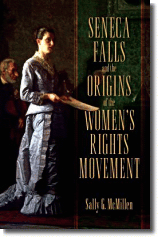 Sally McMillen is the Mary Reynolds Babcock Professor of History and Department Chair at Davidson College. She specializes in Southern and women's history, with an emphasis on the nineteenth century. Among her publications are Motherhood in the Old South: Pregnancy, Childbirth, and Infant Rearing, Southern Women: Black and White in the Old South, and To Raise Up the South: Sunday Schools in Black and White Churches, 1865-1915.
Sally McMillen is the Mary Reynolds Babcock Professor of History and Department Chair at Davidson College. She specializes in Southern and women's history, with an emphasis on the nineteenth century. Among her publications are Motherhood in the Old South: Pregnancy, Childbirth, and Infant Rearing, Southern Women: Black and White in the Old South, and To Raise Up the South: Sunday Schools in Black and White Churches, 1865-1915.She applied the "Page 99 Test" to her latest book, Seneca Falls and the Origins of the Women’s Rights Movement, and reported the following:
Page 99 of my new book, Seneca Falls and the Origins of the Women’s Rights Movement, reveals only a snippet of what the book covers. It identifies the Seneca Falls Convention of 1848, the first public meeting held to demand women’s equality, as a pivotal moment in American history. Ultimately it changed the lives of half our nation’s population.Read more about Seneca Falls and the Origins of the Women’s Rights Movement at the Oxford University Press website, and learn more about Sally McMillen at her faculty webpage.
The book covers the nineteenth-century women’s rights movement, first revealing how laws, scripture, and tradition kept women in a dependent state. They lacked access to higher education and to equal wages; they were excluded from most professions. They could not vote or hold public office. If married, their husbands claimed their possessions and wages. Gradually, through their involvement in the anti-slavery struggle, a few women awakened to the fact that they were nearly as oppressed as the slaves they were trying to free. That realization galvanized several women, including four heroines of this tale—Lucretia Mott, Elizabeth Cady Stanton, Lucy Stone, and Susan B.Anthony. They and other women and a few men worked tirelessly throughout most of their adult lives to win equal rights and opportunities for women.
Page 99, which falls in the third chapter covering the Seneca Falls Convention, reveals public reactions to that meeting. Admittedly, as the page reveals, a few newspapers gave the Convention positive press, but most Americans were appalled at such daring challenges to women’s secondary status. Former slave Frederick Douglass, who attended the Convention and supported women’s demands, is quoted on that page. He hit the nail on the head when he observed with a touch of cynicism: “A discussion of the rights of animals would be regarded with far more complacency by many of what are called the wise and good of our land, than would be a discussion of the rights of women.” He added that someone would be accused of evil thoughts who dared “think that woman is entitled to rights equal with man.”
The remainder of the book details the protracted and difficult struggles as activists held annual conventions, petitioned, lectured, wrote, and pleaded with Congress and state governments to give them the right to vote. Their tale is an inspiring one—and provides an understanding of how a few brave and tireless women fought for their rights. So resistant was this nation to female equality that it took seventy-two years, from 1848 until 1920 and the passage of the Nineteenth Amendment, to achieve the rights that women enjoy today.
--Marshal Zeringue



